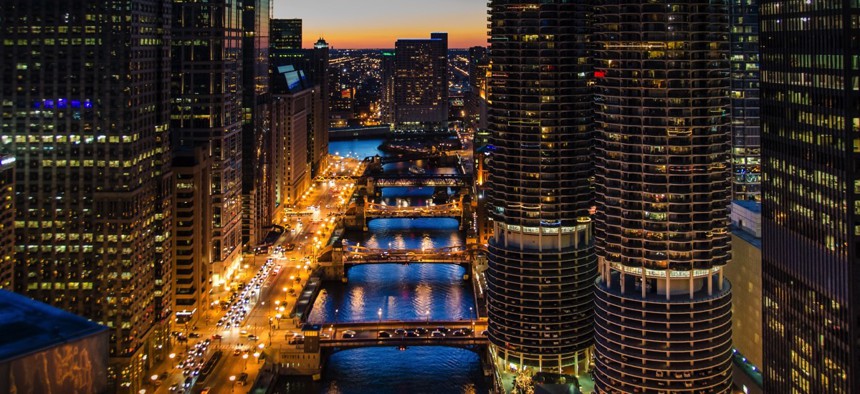Chicago Wants Its Rivers to Be Swimmable

Chicago River at night.

Connecting state and local government leaders
The city’s new vision for clean and safe waterways is either wishful thinking or incredibly ambitious.
Mayor Rahm Emanuel and the Metropolitan Planning Council revealed a grandiose vision for making Chicago’s rivers swimmable by 2030 and completely litter- and odor-free by 2040.
Our Great Rivers is essentially a municipal wish list of 26 goals for the Calumet, Chicago and Des Plaines rivers and 150 miles of riverfront—compiled through civic engagement with more than 6,000 residents at 120-plus community events.
The report recommends improving real-time water quality information and developing ecologically sensitive shoreline by 2020, as well as promoting continuous riverfront trail access and integrating transit on water and land by 2030.
But swimming?
"Swimming in any of the city's rivers right now is definitely a bad idea because there's a long legacy of contamination," Josh Mogerman, Natural Resources Defense Council spokesman, told WTTW's Chicago Tribune.
The U.S. Environmental Protection Agency ordered the city to make stretches of river clean and safe for recreational activity in 2011, the Tribune reported, but testing by the Metropolitan Water Reclamation District last summer found high levels of bacteria from human waste in more than 12 locations along the Chicago River.
Residents haven’t been quick to forget “Poopgate,” that fateful day in August 2004 when a tour bus driver for the Dave Matthews Band dumped its septic tank’s 800-plus pounds of human excrement off the Kinzie Street Bridge and onto dozens of sightseers on an architecture cruise of the Chicago River.
“There has to also be a willingness to believe it’s possible by potential swimmers,” MPC Director Josh Ellis told Chicago Tonight. “We got 14 years. I think it’s definitely feasible.”

To its credit, MWRD has come around to fully treating wastewater before releasing it into Chicago’s rivers, but swimming will live or die on the completion of the Deep Tunnel Project by 2029. The tunnel would greatly reduce the raw sewage dumped into waterways during severe rainfall, Chicago Tonight reported.
While the project is fully funded, it’s a mystery where the money for Our Great Rivers will come from. Chicago will have to get creative to avoid overburdening already frustrated taxpayers, which could involve tax relief for property owners investing in riverfront development.
The city has already begun opening new boat houses and reinvented its Riverwalk to promote river tourism and entrepreneurship.
“Our experience re-imagining Chicago’s downtown Riverwalk got us thinking about what a new day would look like for entirely different places along our city’s rivers,” Carol Ross Barney, founder and design principal with Ross Barney Architects, said in the announcement. “These visions in action show what’s possible when we imagine how to transform dormant spaces into inviting, productive and living landscapes.”

By managing invasive species and preserving rivers as parks, thriving ecosystems could begin to emerge.
Reuse of water might give way to reimagined infrastructure by 2040.
"Our Great Rivers reflects many of MWRD’s aspirations: recovering nutrients from our water, making significant investments in nature-based infrastructure to reduce flooding and opening more of our riverfront land for recreation,” said Mariyana Spyropoulos, MWRD board president, in the announcement.
But until the city takes meaningful steps to make that vision a reality, safe swimming in any of Chicago's rivers will be out of reach.
Dave Nyczepir is a News Editor at Government Executive’s Route Fifty based in Washington D.C.

NEXT STORY: Maternal Mortality Rate Spikes in Texas; Budget Ax Looms for North Dakota State Workers





